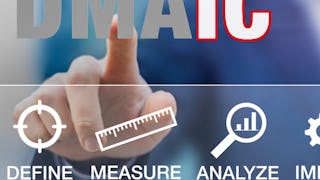This course will provide you will the tools necessary to complete the final components of the analyze phase as well as the improve and control phases of the Six Sigma DMAIC (Define, Measure, Analyze, Improve, and Control) process. This course is the final course in the Six Sigma Yellow Belt Specialization. You will learn about relationships from data using correlation and regression as well as the different hypothesis terms in hypothesis testing. This course will provide you with tools and techniques for improvement. You will also understand the importance of a control plan, as well as its key characteristics, for maintaining process improvements. Every module will include readings, discussions, lecture videos, and quizzes to help make sure you understand the material and concepts that are studied.

4 days left: Get a Black Friday boost with $160 off 10,000+ programs. Save now.


Six Sigma Tools for Improve and Control
This course is part of Six Sigma Yellow Belt Specialization



Instructors: David Cook, PhD
55,149 already enrolled
Included with
(1,351 reviews)
Skills you'll gain
- Cost Benefit Analysis
- Process Improvement
- Project Management
- Statistical Inference
- Quality Management
- Six Sigma Methodology
- Kaizen Methodology
- Continuous Improvement Process
- Correlation Analysis
- Process Optimization
- Statistical Process Controls
- Process Capability
- Statistical Hypothesis Testing
- Quality Improvement
- Document Control
- Regression Analysis
- Lean Six Sigma
Details to know

Add to your LinkedIn profile
See how employees at top companies are mastering in-demand skills

Build your subject-matter expertise
- Learn new concepts from industry experts
- Gain a foundational understanding of a subject or tool
- Develop job-relevant skills with hands-on projects
- Earn a shareable career certificate

There are 5 modules in this course
Welcome to Six Sigma Tools for Improve and Control! This is the fourth course in the Six Sigma Yellow Belt Specialization. Your team of instructors, Dr. Bill Bailey, Dr. David Cook, Dr. Christine Scherrer, and Dr. Gregory Wiles, currently work in the College of Engineering and Engineering Technology at Kennesaw State University. The next two modules will conclude the Analyze phase of the DMAIC process and in the final two modules you will be introduced to the Improve and Control phase. This module will continue to discussion analysis by explaining correlation and regression. You will learn the meaning of correlation and regression, the different types of analysis, and how it can be used in Six Sigma.
What's included
5 videos1 reading2 assignments
This the final module that covers the Analysis phase of the DMAIC process. Now that you have collected the data and calculated it you will need to determine how to make a statistical conclusion about your findings. In this module you will learn more about the importance of hypothesis testing, how to correctly do a hypothesis test reading as well as how to avoid errors, and statistical significance.
What's included
5 videos2 assignments
This module will introduce you to the Improve and Control phase of the DMAIC process. The first step in this phase is determining improvement techniques to help make improvements to an organization. This module will cover the best and most popular improvement techniques including kaizen and kaizen blitz, PDCA (Plan-Do-Check-Act) cycle, and cost benefit analysis (including cost of quality).
What's included
6 videos2 assignments1 discussion prompt
The final phase of the DMAIC process is the control phase. In this module you will learn about control tools that are useful in maintaining improvements. Communication is a key component of the control phase therefore it is important to develop standardized documentation. You will learn about how to standardize and manage documentation to help maintain processes that were implemented during the improve phase of DMAIC.
What's included
3 videos2 assignments
This module is the "capstone project." You should only complete this project if you have taken all three previous yellow belt specialization courses (Six Sigma Fundamentals, Six Sigma Tools for Define and Measure, and Six Sigma Tools for Analyze), AND you want to complete this specialization. It should be noted that completing the Yellow Belt Specialization does not give the learner "professional accreditation" in Six Sigma. However, successful completion will assist in better preparation for such professional accreditation testing.
What's included
1 reading1 peer review
Earn a career certificate
Add this credential to your LinkedIn profile, resume, or CV. Share it on social media and in your performance review.
Instructors


Offered by
Explore more from Business Essentials
 Status: Free Trial
Status: Free TrialKennesaw State University
 Status: Free Trial
Status: Free TrialKennesaw State University
 Status: Free Trial
Status: Free TrialKennesaw State University
 Status: Preview
Status: Preview
Why people choose Coursera for their career




Learner reviews
1,351 reviews
- 5 stars
80.68%
- 4 stars
15.54%
- 3 stars
2.22%
- 2 stars
0.51%
- 1 star
1.03%
Showing 3 of 1351
Reviewed on Jan 27, 2025
Great course if you are a beginner and looking for general understanding before going to official Six Sigma exam to get tested. Thank you for the access to the learning materials
Reviewed on Dec 25, 2024
Es muy buen curso, el inglesque se maneja es muy facil de entender por lo que tambien te puede servir de practica para futuras conversaciones
Reviewed on Jun 16, 2020
This course gives you a complete overview of what the DMIAC process is. The capstone project is really good because it makes you to utilize the knowledge gained from the previous courses.

Open new doors with Coursera Plus
Unlimited access to 10,000+ world-class courses, hands-on projects, and job-ready certificate programs - all included in your subscription
Advance your career with an online degree
Earn a degree from world-class universities - 100% online
Join over 3,400 global companies that choose Coursera for Business
Upskill your employees to excel in the digital economy
Frequently asked questions
Our applied curriculum is built around the latest handbook The Certified Six Sigma Handbook (2nd edition) and students will develop /learn the fundamentals of Six Sigma. Registration includes online access to all course content, projects, and resources. This price does not include the companion text The Certified Six Sigma Handbook (2nd edition).
To access the course materials, assignments and to earn a Certificate, you will need to purchase the Certificate experience when you enroll in a course. You can try a Free Trial instead, or apply for Financial Aid. The course may offer 'Full Course, No Certificate' instead. This option lets you see all course materials, submit required assessments, and get a final grade. This also means that you will not be able to purchase a Certificate experience.
When you enroll in the course, you get access to all of the courses in the Specialization, and you earn a certificate when you complete the work. Your electronic Certificate will be added to your Accomplishments page - from there, you can print your Certificate or add it to your LinkedIn profile.
More questions
Financial aid available,
¹ Some assignments in this course are AI-graded. For these assignments, your data will be used in accordance with Coursera's Privacy Notice.


